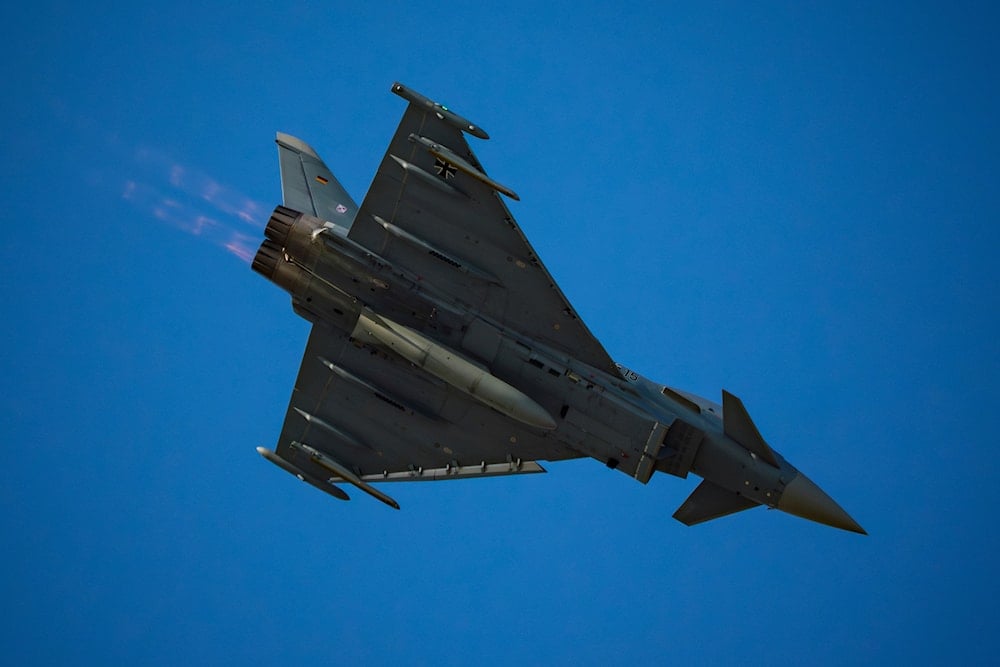Turkiye nears Eurofighter deal with Qatar; Germany lifts export block
Turkiye is nearing an agreement to receive Eurofighter Typhoons originally ordered by Qatar after Germany lifted an export roadblock.
-

An Eurofighter Typhoon German Air Force fighter jet flies above the runway of the Aurel Vlaicu airport, on the first day of the Bucharest International Air Show, BIAS, in Bucharest, Romania, August 30, 2025. (AP)
Turkiye is close to securing a rapid infusion of Eurofighter Typhoon jets through negotiations with Qatar, while a parallel memorandum of understanding with the United Kingdom advances a longer-term procurement track, officials and industry reports say.
The development follows a pivotal decision by Germany to lift an export impediment that had stalled transfers of jointly produced Typhoons; a political turn that has opened a practical pathway for Doha to reassign a tranche of aircraft to Ankara.
Qatar’s role and the mechanics of a fast-track transfer
Doha’s willingness to redirect a portion of its Tranche-3A Typhoons, as media reporting cites figures ranging from roughly 12 to as many as 24 aircraft under discussion, provides Ankara with a near-term option to close an urgent capability gap.
Qatar ordered Tranche-3A aircraft as part of a broader modernization program and, because it operates a mixed fleet including Rafales and F-15QAs, it appears to have the procurement flexibility to reassign some frames or negotiate replacement production slots with BAE Systems and consortium partners. In practical terms, any reallocation would be executed as a commercial and sovereign reassignment of delivery slots and require consortium and export approvals.
For Turkiye, used Tranche-3A jets would serve as a swift operational stopgap while Ankara pursues new-build Typhoons through an MoU with the UK and continues development of its indigenous TF-K/KAAN program. The two-track approach, rapid second-hand acquisitions plus a parallel new-build procurement, shortens the time to capability but adds complexity for training, sustainment, and systems integration.
Read more: Germany mulls buying 15 F-35s as Berlin seeks to modernize air force
MoU implications
Why Germany’s approval mattered?
Eurofighter sales are governed by a consortium model that gives partner states effective control over exports because of shared industrial inputs and component sourcing. Germany’s earlier refusal to greenlight transfers operated as a de facto veto. Berlin cited political concerns tied to Ankara’s domestic and regional policies and used export licensing as leverage in wider diplomatic friction.
That decision effectively blocked straightforward reassignments and forced negotiators to pursue more complicated workarounds. The subsequent reversal removed the central legal and industrial obstacle and allowed consortium negotiations to advance.
Can Qatar replace those Typhoons?
Doha’s broader fighter program gives it credible alternatives to the on-order Typhoons. Qatar fields large Rafale and F-15QA procurements and could rebalance deliveries, accelerate alternative platforms, or negotiate fresh production slots with manufacturers to replace any reallocated Typhoons.
Industry commentary also suggests Doha’s additional Typhoon orders were in part intended to sustain UK production lines; that industrial logic gives both buyer and supplier commercial levers to rearrange schedules without materially degrading Qatar’s overall combat capability. Nevertheless, political, industrial, and scheduling negotiations will determine how quickly and cleanly replacements can be secured, especially amid Qatar's failure to defend against an Israeli strike that targeted its capital on September 9.
Washington, F-35 diplomacy, Ankara’s parallel tracks
Ankara has not abandoned efforts to re-engage Washington on US fighter options. Turkish officials have pursued diplomatic channels, including high-level engagement with the US President Donald Trump, seeking improved relations that could facilitate F-35 or advanced F-16 options.
Re-entry to the F-35 program or a fresh US sale would require Washington to lift prior sanctions or provide waivers stemming from Turkiye’s 2019 purchase of advanced Russian S-400 air defense systems.
Meanwhile, Ankara’s indigenous fifth-generation KAAN fighter is not expected to reach operational status until late 2020s, and F-16 Block 70 procurement or upgrades could face similar delays. In contrast, Eurofighter Typhoons, particularly those redirected from Qatar, could be delivered much sooner.
Read more: Turkey pushes Trump for local production in F-35 and F-16 deals
How Typhoons would reshape deterrence
Technically, Tranche-3A Typhoons and later new-build variants bring a substantive step-up in radar, sensor fusion, survivability, and beyond-visual-range (BVR) lethality when paired with missiles such as the Meteor. The aircraft can be configured in an air supremacy loadout carrying six long-range Meteor missiles, two short-range IRIS-T missiles, and three external fuel tanks.
For Turkiye this means improved early-warning, engagement range and layered air-defence integration compared with an aging F-16 fleet. Rapid second-hand deliveries would therefore strengthen Ankara’s immediate deterrent posture by increasing the qualitative threshold adversaries must consider.
The acquisition of Eurofighter Typhoons significantly enhances Turkiye's air superiority capabilities, providing a robust countermeasure to Greece's advanced air assets, including the Rafale fleet.
Read more: Israeli aircraft violate Turkish airspace, fighter jets scrambled

 5 Min Read
5 Min Read








